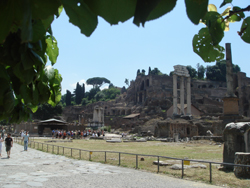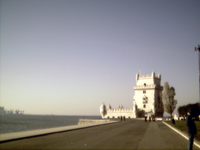 Today,
we took a trip out to Belém to see the Mosteiro
dos Jeronimos and the Torre
de Belém, both of which are on the UNESCO
World Heritage List.
Today,
we took a trip out to Belém to see the Mosteiro
dos Jeronimos and the Torre
de Belém, both of which are on the UNESCO
World Heritage List.
Aware that we were short on time, we jumped into a cab from our hotel to the Torre de Belém (pictured right) on the shores of Lisbon's natural harbour. As we had arrived on a Sunday and entered before 14:00, we were allowed to enter the tower for free. During our visited we were able to visit the upper and lower batteries, the chapel (which had impressive sculpted vaulting), the Kings room and the Governors room. Perhaps most impressively, though, was the visit to the terrace which affords excellent views both accross the harbour and, the other way, towards the Mosteiro.
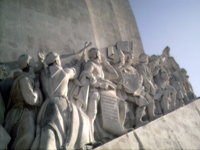 Upon
leaving the Torre de Belém, we took the gentle stoll
to the Padrao dos Descobrimentos - a huge monument to those
Portugese who participated in the Age of Discoveries. Amongst
those who are featured on the monument include:
Upon
leaving the Torre de Belém, we took the gentle stoll
to the Padrao dos Descobrimentos - a huge monument to those
Portugese who participated in the Age of Discoveries. Amongst
those who are featured on the monument include:
- Henry the Navigator (sponsor of the Age of Discovery)
- Vasco da Gama (discoverer of the sea route to India)
- Pedro Álvares Cabral (discoverer of Brazil)
- Ferdinand Magellan (first to circumnavigate the globe)
- Diogo Cão (first to arrive to the Congo river)
- Bartolomeu Dias (first to cross the Cape of Good Hope)
- Afonso de Albuquerque (second viceroy of Portuguese India)
- Lu�s de Camões (renaissance poet who celebrated the navigations in the epic Lusiads)
- King Manuel I (ruler on the Age of Discovery)
- Pedro Nunes (16th century mathematician)
- Nuno Gonçalves (15th century painter)
Before heading into the Mosteiro dos Jeronimos, we stopped in the Pastéïs de Belém for some excellent coffee and pastries. The Pastéïs de Belém is a surprisingly large place - in that it's only a small place from the outside but has several large rooms behind. I recomend the Custard tartlets which are produced and consumed in huge numbers and are, therefore, suitably fresh.
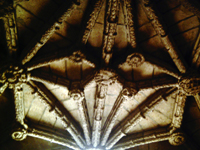 The
Mosteiro dos Jeronimos was ordered to be built by Manuel I
in memory of Vasco da Gama;s discover of a sea route to India.
Manuel I and many of his descendants are entombed in the monastry
now. Work on the Gothic design
began in 1502 by Diogo de Boitaco. Following the death of Diogo
de Boitaco, construction was continued by João de Castilho
with a more Renaissance style - which is apparent towards the
alter - and later by Diogo de Toralava and Jérome de
Rouen (Jerónimo de Ruão.) On entry to the Monastry
(through the façade dominated after designs by João
de Castilho), walk in a straight line from the centre of the
door towards the alter and enjoy the visual effect as the Cathedral
opens up in front you. The exterior is heavily decorated and
very ornate and intricate. It's worth stopping for a little
while to examine the carvings. On the interior, the pillars
are highly carved and intricate. But to me, one of the most
fascinating aspects of the interior of the Church is the groin
vaulting of the ceiling.
The
Mosteiro dos Jeronimos was ordered to be built by Manuel I
in memory of Vasco da Gama;s discover of a sea route to India.
Manuel I and many of his descendants are entombed in the monastry
now. Work on the Gothic design
began in 1502 by Diogo de Boitaco. Following the death of Diogo
de Boitaco, construction was continued by João de Castilho
with a more Renaissance style - which is apparent towards the
alter - and later by Diogo de Toralava and Jérome de
Rouen (Jerónimo de Ruão.) On entry to the Monastry
(through the façade dominated after designs by João
de Castilho), walk in a straight line from the centre of the
door towards the alter and enjoy the visual effect as the Cathedral
opens up in front you. The exterior is heavily decorated and
very ornate and intricate. It's worth stopping for a little
while to examine the carvings. On the interior, the pillars
are highly carved and intricate. But to me, one of the most
fascinating aspects of the interior of the Church is the groin
vaulting of the ceiling.
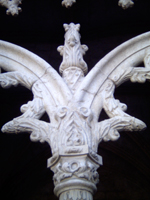 The
cloister of the Monastry was a great place to visit. The stonework
is highly detailed and reveals much of the work that must have
gone into the construction of both the Cloister and the Monastry.
The
cloister of the Monastry was a great place to visit. The stonework
is highly detailed and reveals much of the work that must have
gone into the construction of both the Cloister and the Monastry.
Having enough time, we took the number 15 tram back to town - buying our ticket on board from one of the machines. We jumped off the tram in Baixa and gently wandered in the direction of our hotel grabbing a quick bite to eat before setting off for Zürich.
